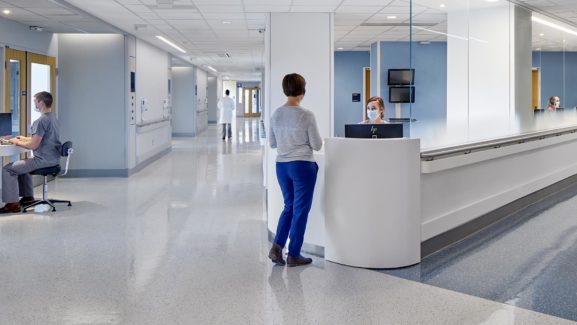
Pediatric Transplant Programs Excelling Thanks to High Volumes, More Living Donors, and Dedicated Teams
At the tail end of Donate Life Month comes National Pediatric Transplant Awareness Week, celebrating “the gift of life provided through pediatric donation and transplant.” Here at UVA Health, we have much to celebrate. Our pediatric transplant programs — heart, liver, and kidney — have seen incredible success in the past year. More successful pediatric organ transplants mean more kids have a chance to live life to the fullest.
Pediatric Vs. Adult Transplant Care
There are special considerations for pediatric organ transplant that require the added expertise of a multidisciplinary team who understand the medical, emotional, and developmental needs of pediatric patients. Some of the key factors that distinguish the care and treatment of these patients include:
- Organ size — smaller organs can be more difficult to match and require advanced surgical techniques to implant. Plus, kids’ bodies are growing and changing, so the care team has to plan ahead to ensure the organ will be a long-term fit.
- Family dynamics — parents and other caregivers are an essential part of a child’s care team. As the decision-makers, nurturers, and providers, they’re facing a very trying experience, and they require education and support at every stage of their child’s transplant.
- Psychosocial support — A child navigating a serious illness can struggle developmentally and emotionally. Additional support to help them manage stress, stay on track and maintain their quality of life is integral to ensuring their overall well-being.
- Lifelong care — Many pediatric organ recipients will need lifelong care. It’s up to our pediatric transplant team to monitor graft function, a child’s growth and development, and signs of complications, and also help kids and families transition to adult care at the appropriate time.
A Record Year for Pediatric Heart Transplants
The only active pediatric heart transplant program in Virginia, UVA Health Children’s Heart Center performed 18 pediatric heart transplants in 2023 — the highest number to date. This impressive stat is indicative of a flourishing congenital heart center, which has seen tremendous growth, not only in heart transplant, but also cardiothoracic surgery, the ventricular assist device (VAD) program, and the intensive care unit (ICU).
“Each year, there is an increase in the number of children seeking and benefiting from our cardiac surgical, inpatient and outpatient care. The majority of the referrals we receive are babies and children with complex congenital heart disease. When these defects are inoperable or they develop heart failure refractory to medical therapies, their only chance at survival is heart transplantation. With the growing volumes of the former, there has been a commensurate growth in the latter,” says pediatric transplant cardiologist Michael McCulloch, MD.
UVA Children’s Heart Center has become one of the region’s premier programs for the treatment of congenital heart disease, and we’re committed to helping ensure kids receive the care they need no matter where they call home. That’s why we created the Virginia Congenital Cardiac Consortium or VC-3. It is the first such collaboration between three academic pediatric congenital heart programs: UVA Children’s, Children’s Hospital of Richmond at VCU, and Children’s Hospital of Kings Daughters. The goal was to create a broad network of care that extends across the Commonwealth, providing kids the right treatment at the right time regardless of where they enter the VC-3 system. Through this program, we can provide earlier interventions and seamless access to our tiniest patients who need complex cardiac care leading to heart transplant.
Making a Case for Pediatric Living Liver Donation
UVA has the only pediatric liver transplant program in Virginia. Our partnership with Children’s Hospital of Pittsburgh of UPMC and the onboarding of two leading physicians have helped transform this program. Since their arrival, pediatric hepatologist Frank DiPaola, MD, Director of Pediatric Hepatology and Medical Director of Pediatric Liver Transplantation, and transplant surgeon Nicolas Goldaracena, MD, Surgical Director of the UVA Living Donor Transplant Program and UVA Pediatric Liver Transplant Program, have helped further bridge the gap between pediatric liver supply and demand by providing more advanced care and more complex procedures.
“We are now able to offer alternatives for pediatric liver transplant that are more technically challenging — living donations, organ splits, and the domino transplant — that allow us to give kids access to transplant sooner,” says Goldaracena.
After a 15-year pause, living donations have resumed and continue to increase in number. Since July 2022, the pediatric liver transplant team has done 9 living donor transplants with great outcomes. “We’ve really seen a culture shift toward living donation being something that is the first thing we think about for all of our patients, but particularly with our pediatric patients, who are often the sickest and most vulnerable,” says 27-year Transplant Program veteran and Lead Living Donor Transplant Coordinator Anita Sites, NP.
“Access to organs for kids is really the big issue. Kids are waiting too long. They have to get fairly sick on the deceased donor waiting list to have a score that will result in a reasonable likelihood of transplant,” adds DiPaola. “This places a strain on families and, as a secondary issue, strains the medical system since sicker kids require more intensive management. Also, in the hands of experienced team, outcomes for living donor transplants are better.”
The shift to living liver donation can be attributed to its many advantages, including:
- Shorter waiting periods
- Shorter length of stay
- Improved size matching
- Healthier organs that function immediately upon transplant
- Longer lasting organs
- Regrowth of donor livers
One of the greatest advantages, according to Sites is the ability to transplant kids before they’re hospitalized. She says: “Many of these kids are coming in from home for their transplant, and they seem to do a lot better.”
For Pediatric Kidney Transplant, Focus Is on Family
Over the past five fiscal years, the pediatric kidney transplant program has experienced remarkable growth, boasting over 40 transplants. This impressive achievement is a testament to the dedication of the pediatric transplant nephrology team, led by John Barcia, MD, a renowned pediatric nephrologist.
Like liver transplant, living donation has been the focus and the preferred choice for pediatric kidney transplant patients. “We know that living donor kidneys have many advantages, including decreased time on the waiting list, optimized timing for both the donor and the recipient, superior quality of graft function as the kidney is coming from a healthy, living person. And living donor kidneys typically last longer than kidneys from deceased donors,” explains Sites.
Immediately after patients are referred to us for transplant, Sites meets with families to discuss the advantages of living donation. Unlike living liver donors, whom often are anonymous, kidney living donors are more often related. “It’s usually families who end up donating kidneys,” says Sites. “It has to do with how organs are matched. Kidneys require an immunologic match, which we’re not looking at for liver, so you can’t really compare the two.”
Common Thread: Collaboration and Expertise
Where liver and kidney (and heart) transplant do compare is in the depth of expertise and level of collaboration among the large, multifaceted teams that make pediatric transplant possible.
“For any transplant to take place, whether it's an adult or a child, no matter what organ, to get them to that to the operating room requires a significant amount of time and energy and collaboration from physicians and surgeons, advanced practice providers, nurse coordinators, nutrition, pharmacy, finance, social work, child life specialists, psychology, and others, all working to get this person approved for a transplant,” says Sites. “And that’s just the beginning. Then you have the transplant itself and the long road to recovery. There’s an endless number of people involved. Everyone is key and plays an important part. If just one team member isn't present or able to contribute, then it's not going to go the way that it needs to go.”
Latest News





